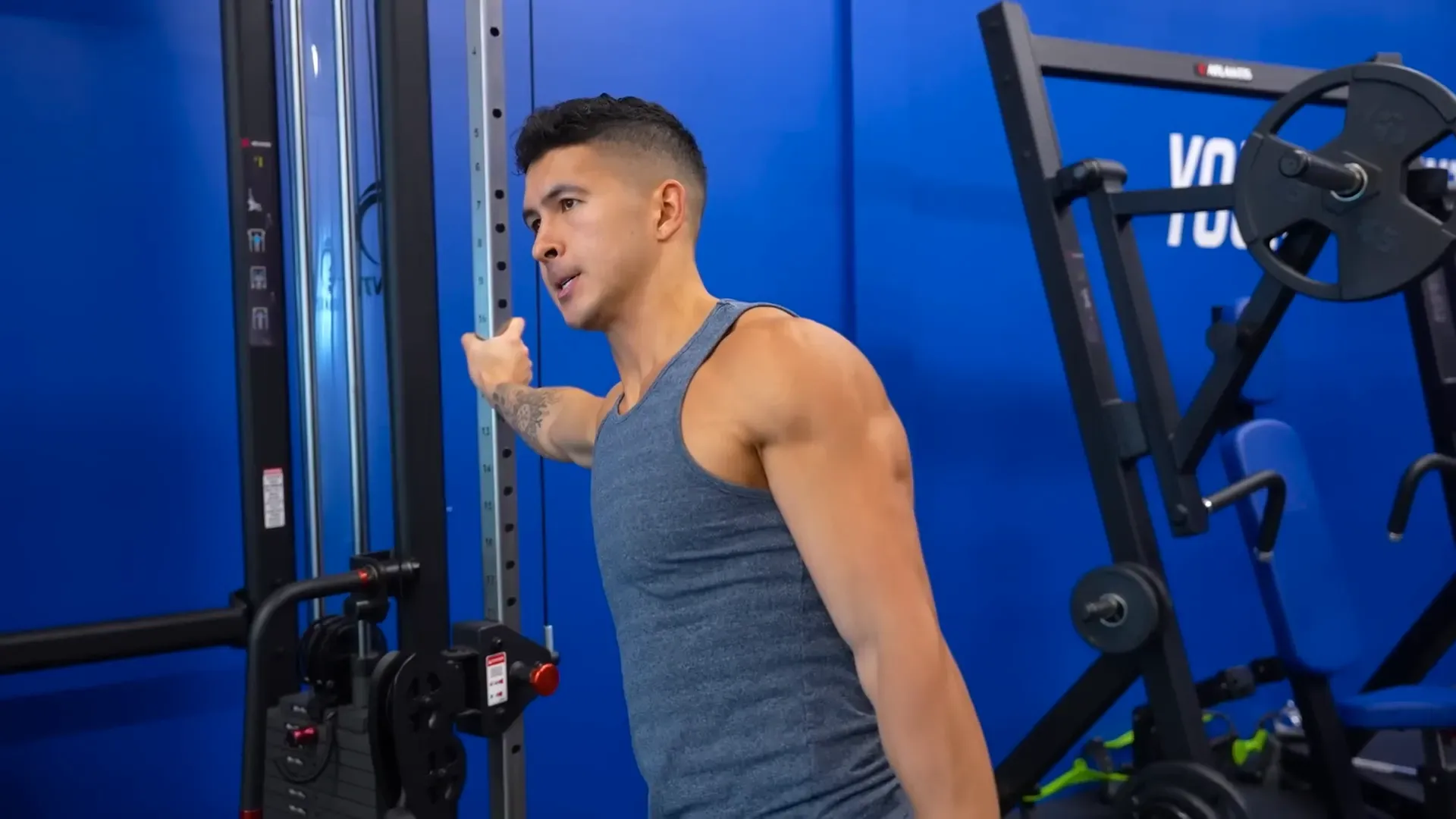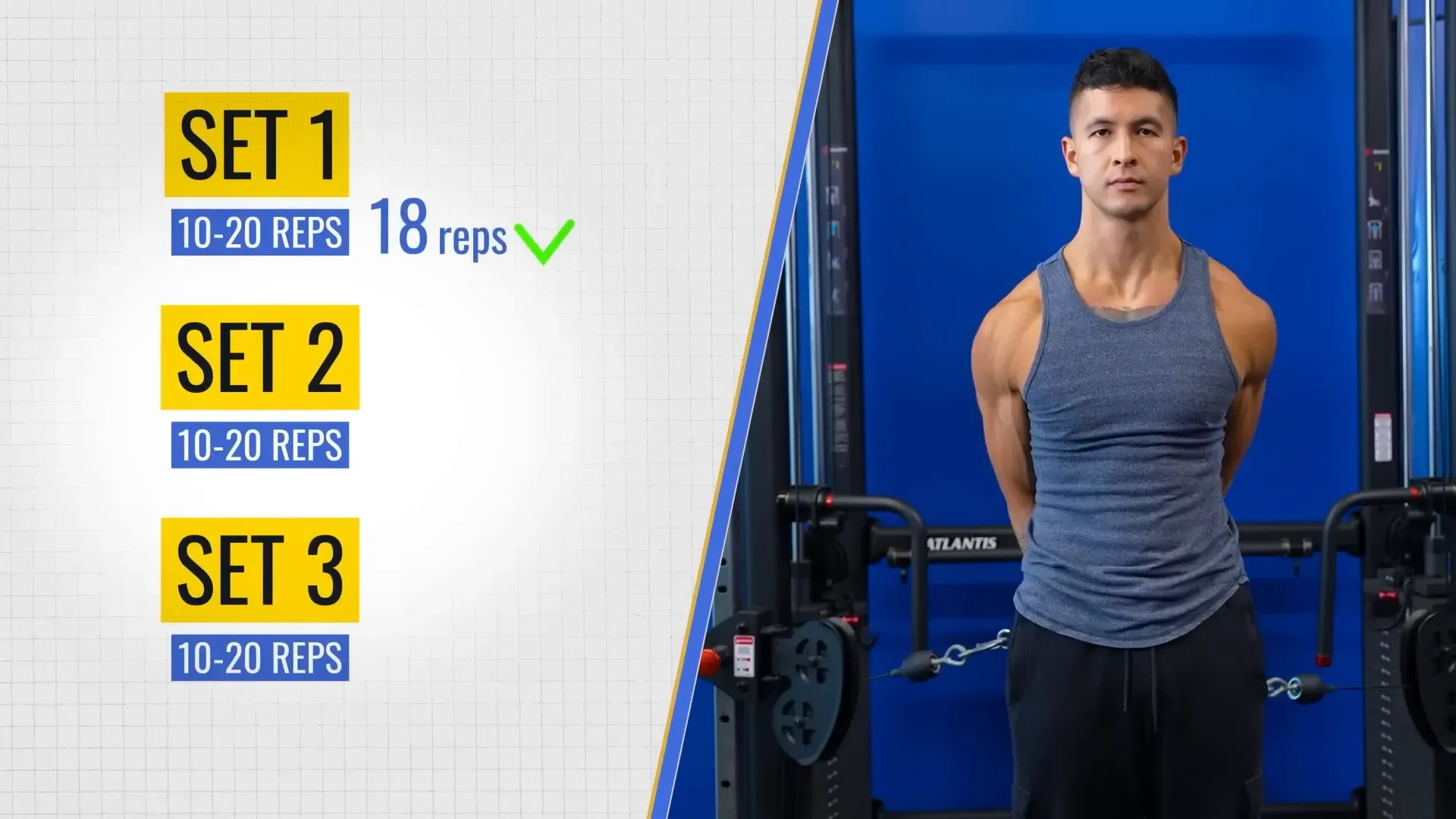Wider Shoulders Workout: Proven Exercises for Muscle Gains
Pro tips to optimize your shoulder development for size, strength, and aesthetics

Key Takeaways
- You need to train your side delts – Wider shoulders come from targeting side delts, NOT just presses. Lateral raises are your best bet!
- Your best exercise is cable lateral raises – They keep tension on your muscles throughout the movement, leading to better growth.
- You should train shoulders twice a week – Give your delts 48 hours between sessions to recover and grow.
- Your form matters more than weight – Stick to 10-20 reps with perfect form before increasing weight.
- You can’t ignore rear delts – Rear delt raises balance your shoulders and prevent imbalances.
Want to make your shoulders wider and more defined?
In this expert review, we analyze, critique, and expand on Jeremy Ethier’s recommended exercises for shoulder growth. We take a deeper look at his approach to side delt activation, common mistakes, and workout effectiveness.
What sets this guide apart?
- Reviewed and fact-checked by experts with over 20 years of gym experience.
- Features training secrets to better isolate and grow your side delts.
- Includes an expert-designed workout based on Ethier’s key principles.
If you want a stronger, more balanced physique, keep reading. This guide will help you train more effectively for maximum shoulder growth.
Related:
- Shoulder Hypertrophy Workouts (15 Best Exercises)
- Dumbbell vs Cable Raises for Delt Muscle Growth: Which Exercise Is Best?
- 11 Little-Known Muscle Growth Exercises You Should Try
In a Nutshell: Get Wider Shoulders the Right Way
Your form matters more than how heavy you lift. Stick to 10-20 reps, perfect your technique, and increase weight gradually (2.5-5 lbs). Training shoulders twice a week with at least 48 hours of recovery will maximize your gains.
You’re on the right track by focusing on progression and consistency. Keep challenging your muscles with better exercises, proper form, and smart programming. Stay dedicated, and those wider shoulders will come!
| Key Concept | Main Insight |
|---|---|
| Side delts vs. front delts | Too much pressing leads to imbalance—focus on width. |
| Best exercise choice | Cable lateral raises provide constant tension. |
| Form over weight | Strict 10-20 rep sets work better than heavy weights. |
| Training frequency | Hit shoulders twice a week with rest days. |
| Rear delt activation | Helps prevent imbalances & supports shoulder health. |
Training for Wider Shoulders
Shoulder training is essential for achieving a well-rounded physique. It plays a crucial role in your overall upper body strength and aesthetics. When you train your shoulders effectively, you enhance your posture, improve your athletic performance, and reduce the risk of injury.
However, many people overlook the importance of targeting the side delts. Instead, they focus on exercises that do not emphasize this area. This can lead to imbalances that detract from the desired width and strength of your shoulders.
Understanding the Side Delts
The side delts, or lateral deltoids, are the muscles that give your shoulders their width. They are located on the outer part of your shoulders. To achieve that V-taper look, your side delts must be well-developed.
These muscles are responsible for shoulder abduction, which is the movement of lifting your arms sideways. When trained properly, the side delts can create an impressive silhouette and contribute to a more powerful upper body.
The Common Mistake in Shoulder Workouts
A common mistake in shoulder workouts is focusing too much on front delts. Most people perform many pressing movements, which primarily target the front delts. This leads to overdevelopment in the front while neglecting the side delts.
When the front delts are overdeveloped, they can overshadow the side delts, resulting in a less balanced appearance. This imbalance can also decrease shoulder stability and increase the risk of injury during other lifts.
The Importance of Training the Side Delts
Training the side delts is vital for achieving broader shoulders. Wider shoulders give you a more athletic appearance and enhance your overall physique. Moreover, well-developed side delts contribute to better shoulder stability and function.
Ignoring the side delts can lead to a lack of shoulder definition. This can make your upper body look less impressive and hinder your progress in other lifts. Prioritizing side delts in your workout routine is essential for achieving your goals.
Fixing the Imbalance in Your Training
To fix the imbalance in your shoulder training, start by reducing the volume of pressing exercises. Instead, allocate more time to lateral raises and other side delt-focused movements. This shift in focus will help you develop the width you desire.
Consider incorporating variations of lateral raises that emphasize the side delts more effectively. Techniques such as cable lateral raises can enhance muscle activation and provide a greater stretch, leading to better growth.
The Best Exercises for Wider Shoulders
To achieve wider shoulders, you need to focus on the right exercises. Here are some of the best options to include in your routine:
- Cable Lateral Raises: These provide constant tension throughout the movement, maximizing the engagement of the side delts.
- Dumbbell Lateral Raises: A classic exercise that targets the side delts effectively. Perform them with proper form to avoid injury.
- Lean-In Lateral Raises: Leaning into the movement shifts the focus to the bottom of the range, enhancing the stretch on the side delts.
- Incline Dumbbell Lateral Raises: This variation targets the rear portion of the side delts, giving a more complete look to your shoulders.
Incorporate these exercises into your routine for balanced shoulder development and impressive results. Remember, consistency is key to achieving wider shoulders.
Limitations of Dumbbell Lateral Raises
Dumbbell lateral raises are a staple in shoulder workouts. They are straightforward and accessible for most people. However, they come with significant limitations.
One major issue is that they primarily challenge the deltoids at the top of the movement. This is where your muscles are generally weaker. As a result, you often end up using lighter weights than you could handle effectively.
Additionally, lateral raises with dumbbells do not provide an optimal stretch for the side delts. Research indicates that exercises that emphasize a stretch position can lead to better muscle growth. Dumbbell lateral raises fall short in this aspect.
Exercise 1: Cable Lateral Raises
Cable lateral raises offer a superior alternative to dumbbell variations. They allow you to maintain constant tension throughout the movement. This keeps your side delts engaged at all times.
To perform cable lateral raises effectively, start by setting the cable at a slightly elevated position. This adjustment shifts the challenge to the beginning of the movement, where your side delts are more stretched.
Lock your elbow into your side and rotate your arm outward. Raise your arm in a straight line, moving slightly behind your torso. This method maximizes tension and emphasizes the stretch at the bottom.
Research on Cable vs. Dumbbell Raises
Recent studies have compared cable and dumbbell lateral raises to determine their effectiveness. In one study, participants performed both exercises over eight weeks. Researchers measured hypertrophy in the side delts using ultrasound.
Results showed that both cable and dumbbell raises could effectively promote growth. However, there was a slight edge in favor of cable raises for one measurement site. This suggests that cable lateral raises may be more beneficial overall.
It's important to note that the cable raises in this study were done with the arm in front of the body. This positioning does not provide as much stretch as raising the arm behind the body. Further research is needed to draw more definitive conclusions.
Alternative Options for Beginners

If you're new to lateral raises, you may find cable variations challenging. Don't worry; there are alternatives to help you build strength and confidence.
Start with standard dumbbell lateral raises. Focus on perfecting your form. Once you can perform them with ease, consider incorporating partial reps. After reaching failure with full reps, switch to lighter dumbbells and perform partial reps in the bottom range.
Another beginner-friendly option is the lean-in dumbbell lateral raise. Leaning into the movement shifts the challenge to the bottom of the range, effectively targeting the stretch position.
Targeting the Rear Portion of the Side Delt
To achieve well-rounded shoulder development, you need to target the rear portion of the side delts. This area often gets neglected in standard lateral raises.
For cable lateral raises, set the cable at wrist height. Grab the cable in front of your body and rotate about 45 degrees toward it. This adjustment allows you to line up the tension more towards the rear part of your side delt.
As you raise your arm, keep it slightly behind your torso. You may not be able to lift as high as in standard lateral raises, and that’s okay. Focus on maintaining tension in the muscle throughout the movement.
Key Principles for Effective Lateral Raises
When performing lateral raises, it's essential to keep a few key principles in mind. First, focus on form over weight. Small increases in weight can lead to form breakdown if you’re not careful.
Maintain a broad rep range, typically between ten to twenty reps. Once you can perform at least fifteen controlled reps, consider increasing the weight. Use smaller increments, like five-pound plates, to ensure you can maintain your form.
Lastly, program your lateral raises thoughtfully. Balance volume and recovery to suit your body. This approach will help you achieve consistent progress in your shoulder development.
Progressing Your Shoulder Workout

To maximize your shoulder gains, progression is key. You need a strategy that combines both weight and rep increases. This method ensures continuous muscle adaptation and growth.
First, establish a solid baseline. Start with a weight that allows you to perform 10-20 reps with good form. Once you can consistently hit the upper range, it's time to increase the weight.
When increasing weight, do so in small increments. A jump of 2.5 to 5 pounds can make a significant difference. This helps in maintaining proper form while still challenging the muscles.
Additionally, vary your rep ranges. Incorporate lower rep ranges (around 6-8) with heavier weights occasionally. This technique can stimulate different muscle fibers, leading to enhanced growth.
Programming Your Shoulder Exercises
Programming your shoulder workouts effectively is crucial. Balance your volume to ensure both side and rear delts get sufficient attention. A common approach is to perform side delt exercises twice a week.
On your shoulder day, start with compound movements that engage multiple muscles. Follow this with isolation exercises targeting the side delts. This sequence helps in maximizing muscle fatigue.
- Example Routine:
- Warm-up: Dynamic stretches for shoulders
- Compound Exercise: Overhead Press (3 sets of 8-10 reps)
- Isolation Exercise: Cable Lateral Raises (3 sets of 12-15 reps)
- Isolation Exercise: Rear Delt Cable Raises (3 sets of 12-15 reps)
- Finisher: Dumbbell Lateral Raises (3 sets to failure)
Incorporate rest days to allow recovery. Muscles grow during recovery, not just during workouts. Aim for at least 48 hours of rest before targeting the same muscle group again.
Conclusion and Next Steps
Achieving wider shoulders requires dedication and focus. Prioritize your side delts in your training. Use the right exercises and progression strategies outlined here.
After establishing a solid routine, track your progress. Adjust your weights and reps as needed to continue challenging your muscles. Consistency will lead to results.
Consider incorporating new techniques or variations to keep your workouts fresh. This can prevent plateaus and maintain your motivation.
The Ultimate Wider Shoulders Workout
Building wider shoulders isn't just about lifting heavy—it’s about targeting the side delts strategically for maximum growth. This workout plan is inspired by Jeremy Ethier and is based on the key insight that focusing on lateral raises and minimizing front delt dominance leads to a broader, more balanced shoulder appearance. This plan combines high-tension movements, progressive overload, and optimal recovery to ensure steady growth.
Overview
- Ideal for: Anyone looking to broaden their shoulders and enhance side delt development
- Equipment needed: Dumbbells, cables, adjustable bench
- Frequency: Twice a week for optimal results
- Focus: Prioritizing side and rear delts while managing front delt dominance
Workout Split
- Day 1: Shoulder-Focused Workout (Side Delt Priority)
- Day 2: Lower Body (Rest for Shoulders)
- Day 3: Upper Body (Minimal Shoulder Pressing)
- Day 4: Shoulder-Focused Workout (Rear Delt & Side Delt Focus)
- Day 5: Full Body or Active Recovery
Day 1: Shoulder-Focused Workout (Side Delt Priority)
| Exercise | Sets | Reps | Rest |
|---|---|---|---|
| Cable Lateral Raises | 3 | 12-15 | 30s |
| Dumbbell Lateral Raises | 3 | 10-12 | 30s |
| Lean-In Lateral Raises | 3 | 12-15 | 30s |
| Overhead Press (Optional) | 3 | 8-10 | 60s |
| Rear Delt Cable Raises | 3 | 12-15 | 30s |
Pro tips:
- Start with cables to ensure constant tension on the side delts.
- Keep strict form on lateral raises—avoid swinging.
- If overhead pressing, keep volume low to prevent front delt overuse.
Day 4: Shoulder-Focused Workout (Rear Delt & Side Delt Focus)
| Exercise | Sets | Reps | Rest |
|---|---|---|---|
| Rear Delt Cable Raises | 3 | 12-15 | 30s |
| Incline Dumbbell Lateral Raises | 3 | 10-12 | 30s |
| Cable Lateral Raises | 3 | 12-15 | 30s |
| Lean-In Lateral Raises | 3 | 12-15 | 30s |
| Face Pulls | 3 | 12-15 | 30s |
Pro tips:
- Keep rear delts engaged by slightly tilting forward on rear delt raises.
- Use slow, controlled movements for maximum time under tension.
- Prioritize light-to-moderate weights—rear delts respond best to higher reps.
Notes on Program Execution
- Prioritize strict form – Side delts grow best when worked with perfect technique and controlled reps.
- Train shoulders twice a week – 48 hours of recovery ensures maximum growth.
- Balance pressing volume – Avoid front delt overuse by limiting heavy overhead pressing.
Final Thoughts on This Wider Shoulders Workout
This workout plan is designed to maximize side and rear delt growth, ensuring wider, more balanced shoulders. By emphasizing cable lateral raises, strict form, and strategic exercise selection, this program keeps front delts in check while prioritizing the muscles that actually create width.
Want to automate that workout and more? Put your progress on autopilot with Dr. Muscle AI. Try it free.
Expert Corner: Proven Strategies & Hidden Gems
Practical Applications
- Shift focus to side delts – If your routine is heavy on presses, swap one pressing movement for 3-4 sets of cable lateral raises twice a week. This ensures balanced shoulder development.
- Use cables for constant tension – Instead of just dumbbell lateral raises, add cable lateral raises to your routine. Set the cable slightly behind your body to maximize the stretch on your side delts.
- Train within the right rep range – Stick to 10-20 reps per set. Once you can hit 15+ reps with good form, increase weight in 2.5-5 lb increments for steady progress.
- Balance shoulder workouts – Avoid overloading front delts. A simple fix? For every front-delt movement (presses), add at least two side or rear delt exercises to your session.
- Track your progression – Keep a log of weights, reps, and exercises. If you’re not increasing weight or reps every few weeks, tweak your approach by adjusting volume or technique.
Examples
- Beginner fix: Struggling with lateral raises? Start with lean-in lateral raises to better hit the side delts, then transition to cables for constant tension.
- Advanced tweak: Already doing lateral raises? Switch to cable lateral raises with wrist-height setup to emphasize the rear portion of the side delt for a fuller look.
Fact-Check of Key Points
- Cable lateral raises vs. dumbbells – While cables provide constant tension, dumbbells still effectively build side delts. The claim that cables are superior in all cases might be oversimplified. Both tools have their place depending on your training style and goals.
- Stretch-based growth emphasis – The article highlights the importance of the stretch position for muscle growth, which is true to an extent. However, peak contraction and full range of motion also play a big role in hypertrophy. Stretch-based training isn’t the only factor for side delt development.
- Rear delts and side delt balance – While hitting the rear portion of the side delts helps overall shoulder aesthetics, rear delts are a separate muscle group. The phrasing could be clearer—rear delt exercises help with posture and upper back stability, but won’t directly impact side delt width.
- Pressing movements and side delts – The article suggests pressing movements mostly neglect side delts, but that’s not entirely true. Overhead presses do engage side delts, just not as directly as lateral raises. Eliminating presses completely isn’t necessary—balancing both is key.
- Training frequency recommendations – Suggesting twice a week for shoulders is a solid guideline, but some lifters recover faster and might benefit from higher frequency. Recovery varies based on volume, intensity, and individual factors. Some people can train delts more often if managed properly.
More Little-Known Tips for a Wider Shoulders Workout
- Start Your Workout With a Stretch-Focused Movement – Most people warm up with presses, but kicking things off with cable lateral raises (where the stretch is maximized) can activate the side delts and set them up for better engagement in the rest of your workout.
- Use Slight Body Tilts for Better Muscle Activation – A slight forward lean during lateral raises shifts the focus even more onto the side delts, reducing front delt involvement. Same with lean-in lateral raises—this subtle tweak deepens the stretch, leading to better growth.
- Pause at the Top, Not Just the Bottom – Most lifters rush through lateral raises without maximizing the contraction. Try a one-second pause at the top to increase time under tension, forcing your side delts to work harder.
- Use a Reverse Pyramid for Lateral Raises – Instead of always going light to heavy, flip it! Start with a challenging weight for 8-10 reps, then drop the weight slightly and aim for 12-15 reps, then finish with a lighter burnout set of 15-20 reps. This method torches your side delts.
- Train Side Delts Before Presses (Sometimes) – If your side delts are lagging, prioritize them first. Doing lateral raises before heavy presses means they’re fresh and can get the most effort instead of being an afterthought at the end of your workout.
How Much Time Do You Need to Get Wide Shoulders?
Building wider shoulders takes consistent effort, but noticeable changes can happen within 6-8 weeks if you train twice a week with progressive overload. Side delts respond well to high-rep, controlled movements, so staying consistent with proper form is key.
For significant width gains, expect to train for 3-6 months with a structured routine that prioritizes side delt isolation exercises. Sticking to a solid workout plan, proper recovery, and a high-protein diet will speed up your progress.
5 More Quick Tips for Wider Shoulders
- Pre-Exhaust Side Delts – Start your workout with cable lateral raises to activate the side delts before moving into dumbbell work.
- Keep Tension on the Muscle – Avoid swinging or using momentum in lateral raises—slow, controlled reps lead to better activation.
- Limit Front Delt Involvement – Too much pressing can overdevelop front delts, overshadowing your side delts. Focus more on lateral raises.
- Train Twice a Week – Spacing shoulder workouts 48 hours apart helps maximize growth while avoiding overtraining.
- Use Small Weight Increases – Jumping too heavy too soon can ruin form. Increase weight in 2.5-5 lb increments while keeping strict control.
Science of Side Delt Hypertrophy and Strength
Recent research on side deltoid hypertrophy and strength training suggests that load, volume, and training intensity all play key roles in optimizing muscle growth. While training to failure does not necessarily enhance hypertrophy beyond non-failure training, higher loads tend to produce superior strength gains. Additionally, multiple-set training is generally more effective than single sets for hypertrophy.
Key Findings from Meta-Analyses and Reviews
- Training to Failure: Research indicates that training to muscle failure is not required for hypertrophy or strength gains. However, it may have slight benefits for hypertrophy in trained individuals (Grgic et al., 2020).
- Load and Hypertrophy: Muscle hypertrophy occurs similarly across different loading ranges when volume is equated. However, higher loads (>80% of 1RM) produce greater strength gains (Lopez et al., 2020).
- Training Volume: Multiple-set training results in significantly greater hypertrophy compared to single-set training (Krieger, 2010).
- Exercise Order: Strength gains are maximized in exercises performed first in a workout, but hypertrophy is not significantly affected by exercise sequence (Nunes et al., 2020).
Practical Applications of Science
- Use Progressive Overload: Increasing resistance gradually over time is crucial for strength and hypertrophy.
- Prioritize Volume and Load: Train with multiple sets and moderate-to-high loads to optimize deltoid growth.
- Structure Workouts Effectively: Place side delt exercises earlier in a workout for best strength adaptations.
Scientific Conclusion
For optimal side delt hypertrophy and strength, multiple-set training with moderate-to-high loads is most effective. Training to failure is not necessary but can be beneficial for hypertrophy in experienced lifters. Structuring workouts with progressive overload and sufficient volume maximizes results.
My Opinion on the Best Wider Shoulders Workout
I’ve seen a lot of people swear by overhead presses as the best way to build wider shoulders, and honestly, I disagree. Yes, presses hit the delts, but they emphasize the front delts way more than the side delts. If your goal is shoulder width, pressing alone won’t get you there—you need side delt isolation.
Some lifters argue that you can build big side delts just by going heavier on presses. But I’ve noticed that the people with the widest shoulders in the gym are the ones who prioritize lateral raises, especially cable variations that keep tension throughout the movement. I’ve personally seen more growth focusing on high-rep, controlled lateral raises than from loading up on heavy presses.
That said, I’m not saying never press—it’s still a solid movement for overall shoulder strength. But if you’re stuck in the "press-heavy" mindset and your shoulders aren’t widening, it’s time to shift focus. Drop some pressing volume and double down on side delt work. You’ll notice the difference fast.
Wrapping Up Your Wider Shoulders Workout
Getting wider shoulders isn’t about lifting the heaviest weights—it’s about training smart. That means prioritizing side delts, focusing on strict form, and using cable lateral raises for constant tension. Ditch the press-heavy mindset and start training for real width.
The best results come from consistent progression—but manually tracking every rep, set, and weight? That’s a hassle. Dr. Muscle automates all that, ensuring you progress every session without the guesswork. It’s like having a personal trainer in your pocket.
If you’re serious about shoulder gains, let tech do the work for you. Try Dr. Muscle with a free trial today.
FAQ
What are the best exercises to build wider shoulders?
The best exercises for a wider shoulders workout focus on the side delts. Cable lateral raises, dumbbell lateral raises, lean-in lateral raises, and incline dumbbell lateral raises are key movements. These exercises directly target the side delts, which are responsible for shoulder width.
How often should I train my shoulders for optimal growth?
Shoulders should be trained twice a week for optimal growth. This allows enough volume for muscle stimulation while ensuring 48 hours of recovery between sessions. Overtraining can lead to imbalances and plateaus, so balancing side, front, and rear delt work is essential.
Can I build wider shoulders without using weights?
Building wider shoulders without weights is possible but less effective than using resistance. Bodyweight exercises like pike push-ups and banded lateral raises can help, but weighted lateral raises and cables provide greater muscle activation for side delt growth.
What is the role of diet in developing broader shoulders?
A high-protein diet supports muscle repair and growth, which is essential for broader shoulders. Adequate calories, protein intake, and proper recovery are just as important as training. Without proper nutrition, even the best wider shoulders workout will have limited results.
How can I prevent shoulder injuries during workouts?
Shoulder injuries can be prevented by warming up properly, maintaining strict form, and avoiding excessive weight on lateral raises. Overloading the front delts with too much pressing can lead to imbalances, so side and rear delt exercises should be prioritized. Controlled movements and progressive overload are key to avoiding strain.
What are the best shoulder exercises to include in a 20-minute workout?
A 20-minute shoulder workout should focus on high-efficiency movements. Cable lateral raises, dumbbell lateral raises, and rear delt cable raises maximize activation in a short time. Pairing side delt exercises with short rest periods ensures effective volume within a limited timeframe.
Can I effectively build shoulder muscles with just a 20-minute workout?
A 20-minute workout can be effective if it includes high-rep, time-efficient exercises like cable lateral raises and dumbbell lateral raises. Training with short rest periods and strict form can stimulate muscle growth. However, long-term progression may require longer sessions or increased intensity.
Is it possible to do a 20-minute shoulder workout at home without equipment?
A 20-minute shoulder workout can be done at home using bodyweight movements and resistance bands. Banded lateral raises, pike push-ups, and isometric holds can target the delts. However, for maximum width, weighted resistance is more effective.
How many calories can I burn during a 20-minute shoulder workout?
A 20-minute shoulder workout burns around 100-200 calories, depending on exercise intensity and body weight. Higher reps, shorter rest periods, and compound movements like overhead presses can increase calorie burn. However, shoulder training is primarily for muscle growth, not fat loss.
Can I combine a 20-minute shoulder workout with other muscle groups?
A 20-minute shoulder workout can be combined with arms, chest, or back for an efficient upper body session. Pairing side delts with triceps or rear delts with back ensures balanced development. Keeping high intensity and minimal rest allows effective multitarget training.
What are some effective 20-minute shoulder workouts for beginners?
A beginner-friendly 20-minute shoulder workout should focus on strict form and moderate reps. A good starting routine includes dumbbell lateral raises (3x12-15), cable lateral raises (3x12-15), and rear delt cable raises (3x12-15). Using light weights and gradual progression ensures steady shoulder width growth without injury.

